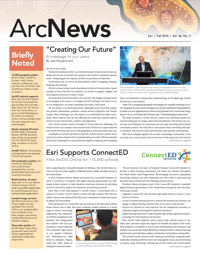Geospatial practitioners are fiercely aware of the importance of maintaining skills and, hence, relevance in a rapidly changing and developing field. Academics, who are responsible for adequately preparing and training members of the geospatial workforce, are similarly challenged with the need to maintain and keep up with the technology, revising courses, and modifying curriculum.
As a geospatial academic for more than 15 years, I have been part of many shifts in the GIS education landscape. Just a decade ago, GIS was typically accessible only as an upper division course, and practitioners cut their teeth in the workplace. Today, students are graduating with degrees and certificates in a variety of geospatially-related specializations. Geospatial technology is continually changing and adapting to the fast-paced nature of our field, while academic programs are constantly challenged to keep up with this pace and accommodate.
There is only so much that a curriculum can pack in at the lower division level: Basic training in the core geographic concepts required for responsible use of the technology and exposure to geospatial components (GIS, remote sensing, cartography, programming, and database) is feasible. While we are able to produce well-trained individuals at this level, the need and desire for more enhanced analytical and technical training at the graduate level has become evident. This has necessitated a paradigm shift in the way we deliver geospatial content at the university level.
More than ever, effective geospatial education requires consistent feedback from the workforce to ensure that training is up to date and adequate. It must go beyond the core concepts and integrate the specific needs of industry and local government. To do this requires a program and curriculum that is informed by and infused with the needs of the workforce.
This has required me to step outside my particular comfort zone and expose what we do in the classroom to professional scrutiny. The result is a different approach to master’s level education in GIS. Our Master of Science in Geographic Information Science (MSGISci) is a new one-year, 30-unit degree program carefully tailored to the needs of working professionals and developed to further core goals and standards of geospatial practice.
The curriculum was framed in consultation with an industry advisory board as well as the Department of Labor’s Geospatial Technology Competency Model (GTCM), an invaluable resource that, as David DiBiase [Esri director of education] believes, is a must read for educators and students, employers, and employees. The GTCM provides a mechanism for identifying not only the requisite skills for our newly designed graduate courses but also standards for learning outcomes and resources for their assessment.
Our program was developed in the spirit of a professional science master’s. This movement in graduate education seeks to combine scientific training with MBA-style course work to provide students with workplace skills typically unavailable in traditional graduate programs. We include three online/hybrid business-style courses: Professional Ethics, Project Management, and Human Resources Management.
The maturity of GIS as a profession is evidenced by the development and institution of our code of ethics and rules of conduct. These serve as a guideline and resource for workplace decision making and as a cornerstone of our required ethics course. Students learn standards of professional practice and codes of ethics that guide responsible conduct in business, governmental organizations, and workplace settings, in general, and apply these to specific geospatial case studies.
Techniques for managing projects from their inception to completion are covered in the course on project management. Students gain an understanding of complexities associated with managing project costs, time, resources, quality, and risks, while the fundamentals of leadership, teamwork, motivation, and organizational strategy are introduced in the course on leadership and management.
Our approach requires scalability in the curriculum. Our training must adjust to a cohort that has varied skill levels, backgrounds, and experiences. This is the sort of situation students may experience in the workplace. In each course, students have the opportunity to expand their training to suit their individual interests and goals.
For example, in the applied GIS course, guest speakers from industry and local government enhance the content by providing insight and exposure to the varied geospatial applications. Students have the flexibility to explore an area of specific interest through an applied project that serves as a potential pilot project for their culminating applied thesis project. Hands-on lab training is integrated with exploration of geospatial concepts such as the modifiable areal unit problem, applied ethics, and spatial statistics.
The applied remote-sensing course brings state-of-the-art concepts and technology into the hands of the students. Students are exposed to a variety of sensors and data collection platforms associated with unmanned aerial vehicles (UAVs). The continually evolving and exciting developments in the burgeoning drone industry are followed with strict attention to Federal Aviation Administration (FAA) rules and requirements. Fast-paced industry developments are followed while students learn how to collect, process, and extract meaningful information from remotely sensed data.
In cartographic visualization, students learn advanced theory and techniques for presentation cartography including communication, visualization, animation, and color. The database class gives students experience planning and configuring an enterprise GIS. This exposes them to the functionality of the geodatabase and use of a relational database management system for storing geospatial data and provides an introduction to web application development for data dissemination.
In the programming class, students who have no coding background and those who have substantial experience explore the use of code to solve specific spatial problems through customization and application development. The program culminates with an applied thesis project that integrates core competencies developed through the curriculum.
The MSGISci program is new. Our first cohort gradated in summer 2014, and our second cohort is in full swing. Assessment is ongoing, and we expect that feedback will continue to inform curriculum development and change. We are confident that this approach to geospatial graduate education will support the goals and standards of geospatial practitioners. For more information, contact Dr. Suzanne Wechsler, MSGISci program director or visit beachgis.com.

